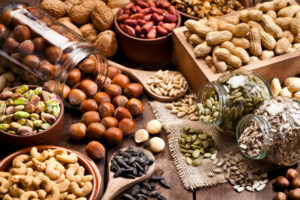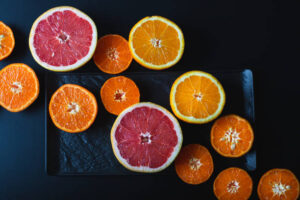It’s a common misconception that vision problems are unavoidable when a person gets older or as a result of repetitive eye strain. In reality, the risk of developing eye health issues can be greatly diminished by adopting a healthy way of life.
Zinc, copper, vitamins C and E, and beta carotene may reduce the risk of age-related decline in eye health by 25%, according to the Age-Related Eye Disease Study (AREDS), published in 2001.
In 2013, the researchers revisited the original formula to see how it would fare under new conditions. Some of the variants tested included omega-3 fatty acids, zeaxanthin, lutein, and beta carotene, with the results suggesting that some combinations are more effective than others.
Research continues to show that omega-3 fatty acids (especially DHA), copper, lutein, and zeaxanthin are all important for healthy eyes.
This article reviews the research on 10 foods high in nutrients that have been shown to improve eye health. We also provide some additional information about how to maintain healthy eyes and some of the warning signs associated with eye problems.
Ten best foods for eye health
Based on the AREDS findings, professional groups like the American Optometric Association (AOA) and the American Academy of Ophthalmology (AAO) maintain dietary guidelines for eye health.
The following 10 nutrient-rich foods have been backed by AREDS reports:
1. Fish

Omega-3 fatty acids can be found in abundance in several types of fish.
By definition, oily fish have oil in their digestive tracts and other tissues, making them a good source of the healthful omega-3 fatty acids. The highest concentrations of healthy omega-3 fatty acids can be found in the following fish:
tuna
salmon
trout
mackerel
sardines
anchovies
herring
Some research suggests that fish oil can alleviate dry eye symptoms, including those brought on by prolonged computer use.
2. Nuts and legumes

Omega-3 fatty acids are abundant in nuts as well. Many nuts are a good source of vitamin E, which helps prevent age-related eye damage.
Nuts can be found in a wide variety of retail and online outlets. Some healthy nuts and legumes for your eyes are:
walnuts
Brazilian nuts
cashews
peanuts
lentils
3. Seeds

Seeds, like nuts and legumes, are an excellent source of vitamin E and contain plenty of healthy omega-3 fats.
You may find seed packets at any supermarket or on the internet. Some examples of omega-3-rich seeds are:
Chia seeds (or chia)
a seed of the flax plant
seed hemp
4. Citrus fruits

Vitamin C can be easily obtained through eating citrus fruits. The American Optometric Association (AOA) suggests taking vitamin C as an antioxidant to protect against age-related eye damage, much like vitamin E.
Citrus fruits that are high in vitamin C include:
lemons
oranges
grapefruits
5. Leafy green vegetables

Both lutein and zeaxanthin, along with the eye-healthy vitamin C, are abundant in dark green vegetables.
Examples of popular leafy greens are:
spinach
kale
collards
6. Carrots
Carrots are an excellent source of both vitamin A and beta carotene. Carrots are naturally orange because of a pigment called beta carotene.
Vitamin A is crucial for healthy eyesight. It is a part of the protein rhodopsin, which aids in light absorption by the retina.
Although studies on beta carotene’s effect on vision have been contradictory, the body need it in order to produce vitamin A.
7. Sweet potatoes
Similar to carrots, sweet potatoes are a good source of the antioxidant beta carotene. In addition, they contain a healthy amount of the antioxidant vitamin E.
8. Beef
Beef’s high zinc content has been linked to improved long-term eye health, according to a reliable source. Reduces the risk of age-related macular degeneration and other vision loss when taken regularly.
Zinc is found in significant concentrations in the eye, especially in the retina and the vascular tissue surrounding the retina.
Zinc can also be found in other types of meat besides beef, albeit at lesser concentrations in foods like chicken breast and pig loin.
9. Eggs
Eggs are rich in the antioxidants lutein and zeaxanthin, which help protect eyesight as we age. Vitamins C and E, as well as zinc, can be found in abundance in eggs.
10. Water
It’s not too surprising that the eyes need a fluid necessary for life.
Dry eye symptoms may be alleviated by maintaining an adequate water intake and so avoiding dehydration.
Recommended daily intake
The American Academy of Ophthalmology (AAO) recommends the following daily intake of nutrients to help keep eyes healthy and delay the onset of eye disease:
Approximately 500 mg of vitamin C
There are 400 IU of vitamin E in this serving.
The equivalent of 10 milligrams of lutein
There is 2 milligrams of zeaxanthin in this formulation.
Specifically, 80 milligrams of zinc oxide
Amounting to 2 milligrams of copper oxide.






